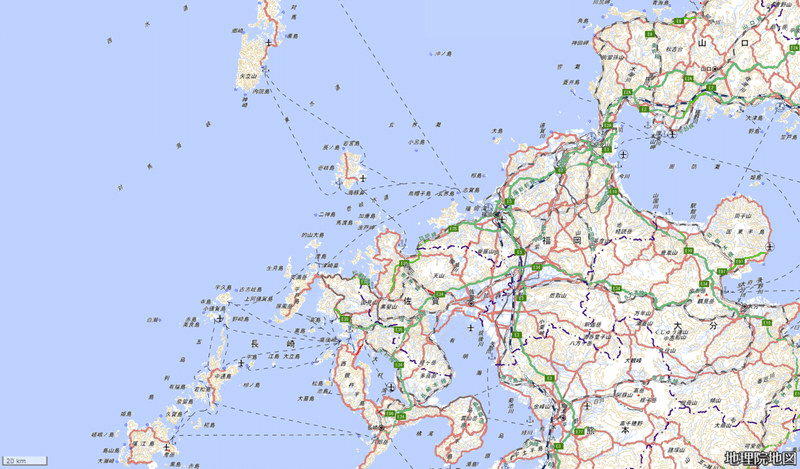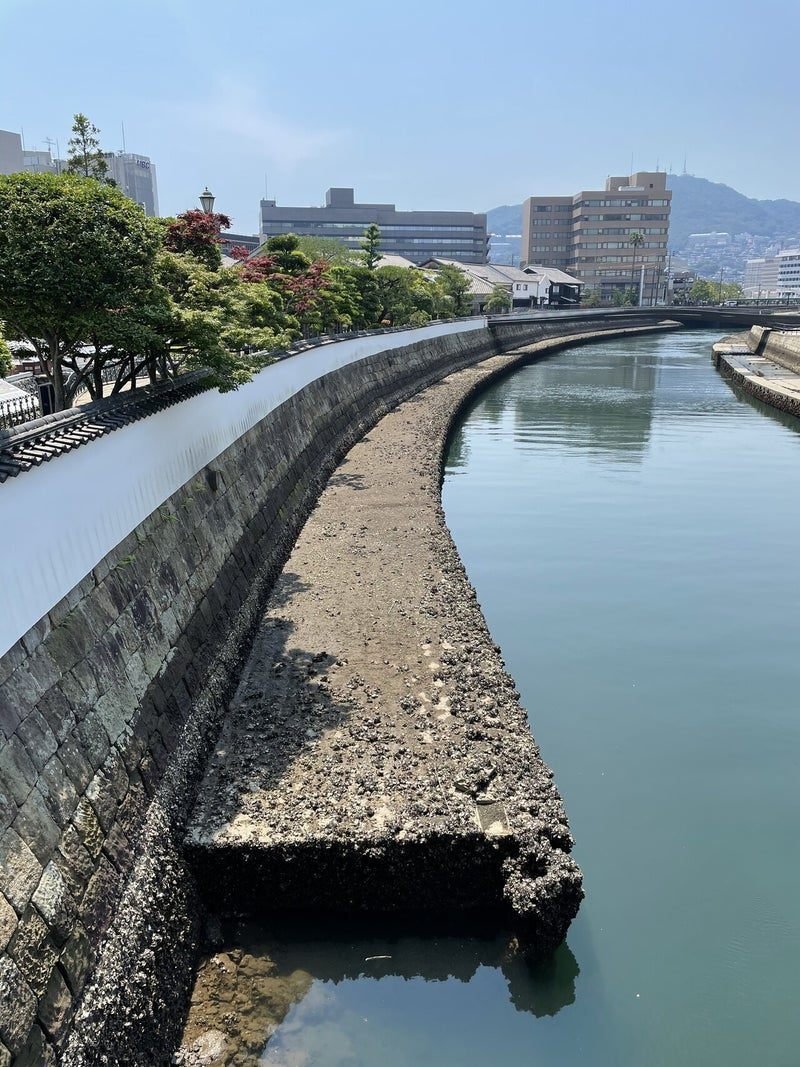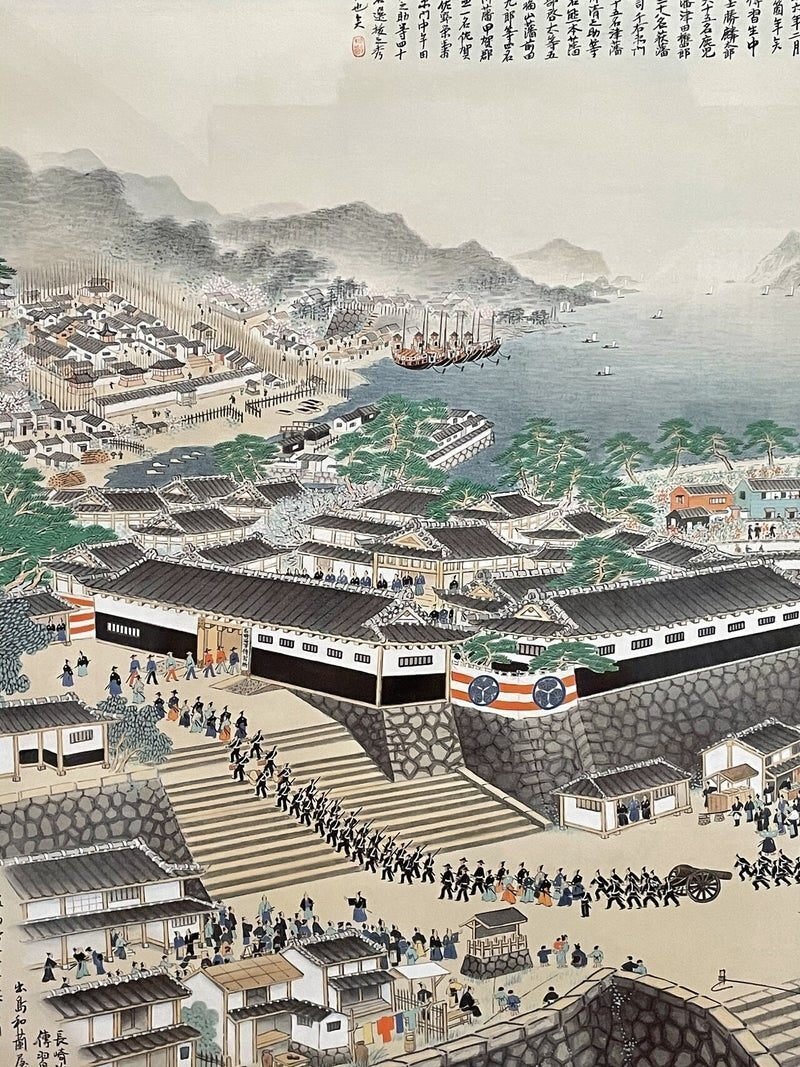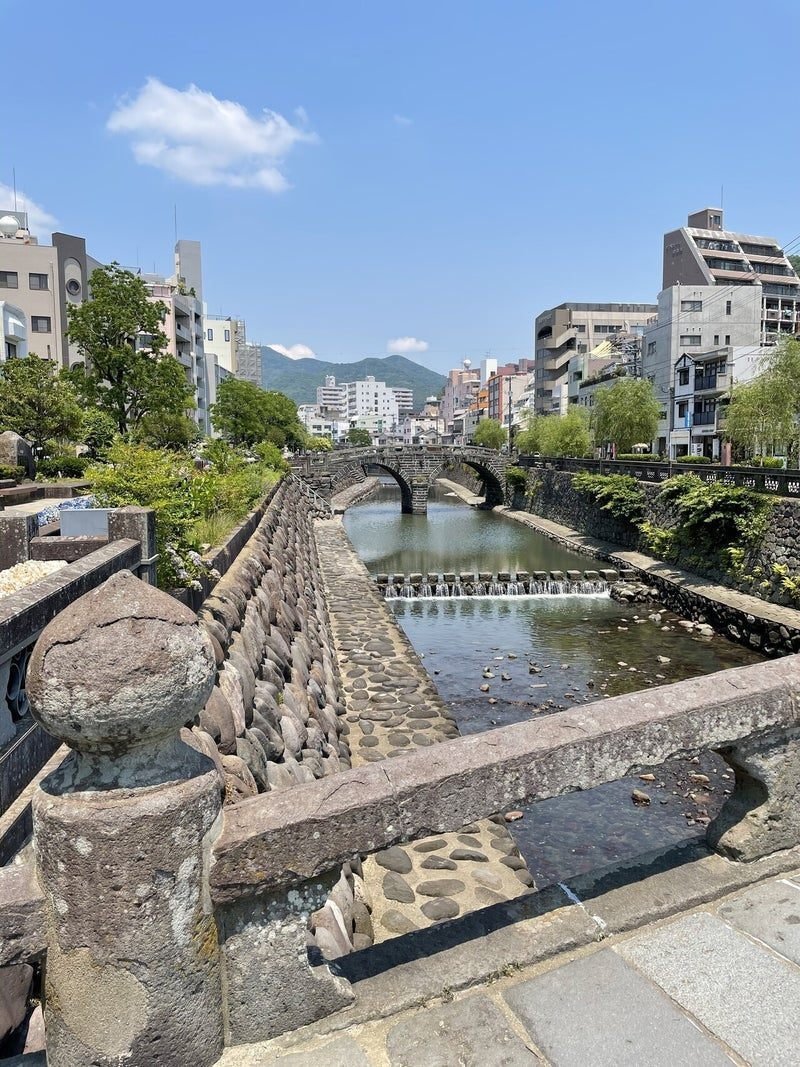
Sketches of Nagasaki in the Edo period: as a gateway to the world
2021/06/25
It was rainy again today in Nagasaki
The names of port towns have a romantic ring to them. Starting from the north of the Japanese archipelago, there are Hakodate, Yokohama, Kobe, and Nagasaki.
As settings for melodramas, each of these port towns have a positive image with foreign residential areas and a scent of different cultures. There is a feeling that new encounters with people and cultures are born there.
For a long time, Nagasaki has been called one of the most beautiful ports in the world, along with Hong Kong and Monaco, boasting stunning night views. Various romances may have been born here on this stage.
For me, when it comes to Nagasaki, I think of the song "It was rainy again today in Nagasaki" (1969). When I was a child, I used to imitate the vocalist, Kiyoshi Maekawa, and sing it without even understanding its meaning.
"I had a love that was only for you, and I believed in your words of love. ♪ Walking on the stone pavement with a feeling of heartache, oh, it was rainy again today in Nagasaki ♪"
When I was young, my impression of Nagasaki was a city of unrequited love, stone pavement, and rain.
I actually set foot in this place during my junior high school field trip and again when I was a college student. I traced the history of the Christian persecution, visited the Peace Park, and learned about the history of the atomic bombing. And the beautiful view of Nagasaki Port from Glover Garden on the hill left a strong impression on me.
After that, unfortunately, I did not have the opportunity to visit Nagasaki again, and the view of the port only repeated in my dreams

"Madame Butterfly" and "Silence"
Nagasaki is known, of course, as a city that was devastated by the atomic bombing, and many people around the world are familiar with its name for this reason.
For foreigners who love opera, some may think of Nagasaki as the setting of Giacomo Puccini's opera "Madama Butterfly" (1904). It tells the tragic love story between an American naval officer, Pinkerton, and a Japanese geisha named Butterfly. The setting and characters, as well as the possibility that the Glover Mansion and its residents served as inspiration, make it an easily accepted theory. It may be difficult to emotionally connect with the exotic story, but the work itself remains popular and is repeatedly performed.
And in recent years, for young people from abroad, it is the presence of British author Kazuo Ishiguro that expands their image of Nagasaki, and perhaps also from the novel "Silence" (1966) by Shusaku Endo.
In 2017, Kazuo Ishiguro, who spent the first five years of his life in Nagasaki, was awarded the Nobel Prize in Literature. His early works "A Pale View of Hills" (1982) and "An Artist of the Floating World" (1986) both feature his imagined version of Nagasaki. Fans of Ishiguro shouldn't miss out on visiting this place.
And a few years ago, Martin Scorsese's film "Silence" (2016) was released. The film was a project that the director had been considering for several decades, and it gained attention in Japan due to the appearance of actor Yosuke Kuboduka. The film is based on the novel by Shusaku Endo, which has been translated into over ten languages worldwide. Thanks to the novel and the film, Nagasaki's name may have become more widely recognized overseas. By the way, there is the Shusaku Endo Literature Museum in the coastal area that served as the setting for the novel, about 40 minutes by car from Nagasaki Station.
In addition, for young people in Japan, the famous destination in Nagasaki would be the theme park "Huis Ten Bosch". Fans of the singer Masaharu Fukuyama may also know that he was born in Nagasaki.

Where is Nagasaki?
Now, Nagasaki City is located to the west of Kyushu, and is about a 2-hour express train ride from Hakata. As you approach Nagasaki Station, the view suddenly opens up and you can see the sea. Along the way, the train winds through small bays, and small settlements can be seen in the mountains, while neatly planted terraced rice paddies line the narrow flatlands. The scenery of the bays and the hillsides is gentle and pleasing to the eye.
Upon arriving at Nagasaki Station, the new platform and station building catch the eye. In front of the station, a vast empty lot stretches out, and large-scale development is underway. I initially thought it was related to a local company, Japanet Takata, but it turned out that JR Kyushu is constructing a station building and a complex facility with the aim of completion in 2023. Additionally, the opening of the Kyushu Shinkansen's West Kyushu Route is expected in the autumn of 2022, making Nagasaki even closer to Fukuoka.
It is difficult to describe the entire map of Nagasaki prefecture in words. To the west of Nagasaki city, across the sea, is the Goto Islands, and to the north are Iki and Tsushima. In the center of the land is Omura Bay, and from there, the Shimabara Peninsula extends southeast and the Nagasaki Peninsula extends southwest. Along the western coastline facing the open sea, there are many capes and bays scattered, with Hirado to the north and Nagasaki to the south serving as the major ports.
By the way, both the headquarters of Japanet Takata and "Huis Ten Bosch" are not located in Nagasaki City, but in Sasebo City on the north side of Omura Bay. They are quite far from the opposite side of Nagasaki City, which is located on the south side of the bay. After arriving at Nagasaki Station, I found myself staring at the map of the entire prefecture.

"The coastal areas of Hizen (which encompasses parts of Nagasaki and Saga prefectures) is said to be wrinkled with many bays and in the Middle Ages, these bays became hotspots for piracy. As the Age of Discovery began in the late Middle Ages, these bays became ports of entry for the culture of the "red-haired Southern barbarians" (a term used to describe Europeans at the time). When tracing the islands and bays of Hizen on a map, one might feel as if the map is not just a map of Japan, but also tinted with the colors of world history." ( "Kaido wo yuku 11: Hizen no Shokaido" by Ryotaro Shiba, published in 1979.)
In the 16th century, the wave of the great Age of Discovery in world history reached the shores of Nagasaki and Hirado on the west coast of Kyushu. Since then, for the next 300 years until the arrival of the Black Ships, Nagasaki became the center of Japan's acceptance of Western civilization. This time, I visited Nagasaki to touch upon its history.
"Sakoku" and "The Four Ports"
To begin with, let's review modern Japan during the Edo period. When thinking of Japan during this time, the impression of "Sakoku" or national isolation may come to mind for many people. Japan closed its doors to the world for hundreds of years, and the image is that the arrival of the Black Ships in the late Edo period suddenly opened the door to foreign countries.
In recent years, however, among historians, it has become the mainstream view that during this period, the Edo Shogunate conducted foreign trade and diplomacy through the "four ports" of Nagasaki, Tsushima, Satsuma, and Matsumae, and had built its own unique international relations that cannot be simplified by the term "sakoku," meaning "closed country."
When you visit some of the historical museums in Kyushu, the story of the "Four Ports" comes up as a preface in the initial explanation. This is probably natural, as three of the four ports are located in Kyushu.
During the Edo period, Japan conducted foreign trade and diplomacy through the "Four Ports". Through these ports, the Matsumae domain traded with Ezo (present-day Hokkaido and Russia's Far East), Satsuma traded with Ryukyu (present-day Okinawa), Tsushima traded with Korea, and Nagasaki traded with Europe and China.
The Tokugawa Shogunate did not completely close off the country from the outside world. Instead, it managed external trade and the flow of cultural artifacts, people, and goods through these four gateways.
The 16th century is considered by historians to be the period of the formation of the "world system," where the world became a single economic unit through trade, and the global economic system that we know today began.
Japan was incorporated into this world system through its connection with Europe, mainly through the port of Nagasaki. In this regard, I would like to emphasize the importance of Nagasaki among the "four ports" in particular.
The Shock of Europe: 100 Years with Portugal
First, let's take a look at the first 100 years of encounter between Europe and Nagasaki in the 16th century.
It is well known that in 1543, a Chinese ship carrying two Portuguese men drifted ashore on Tanegashima, introducing firearms to Japan. Then in 1549, Francis Xavier (1506-1552), a Spanish Basque who founded the Society of Jesus, arrived in Kagoshima and brought Christianity to Japan for the first time. After two years of missionary work in Japan, he died as a guest in China.
In 1550, Portuguese ships carrying missionaries arrived at Hirado. The daimyos welcomed them, provided land, and cooperated in their missionary activities. Eventually, churches were built and schools were established along the west coast of Nagasaki, and Christian culture began to spread.
Then, in 1571, a port was opened in Nagasaki, which became a port of call for Portuguese ships. By the way, this year marks the 450th anniversary of the opening of Nagasaki Port.
The purpose of the Portuguese ships' visits was trade and evangelism. In Kyushu, powerful daimyos such as Sumitada Omura, Sourin oOtomo, and Harunobu Arima converted to Catholicism, engaged in trade, and increased their power within their territories. In 1582, a delegation of four young men, known as the Tensho embassy, was sent to Europe and received a warm welcome on site before returning to Japan eight years later.
During this period, the Western artifacts brought by missionaries and traders included firearms, globes, copperplate engravings, eyeglasses, and Western musical instruments. In addition, knowledge in astronomy, geography, navigation, printing, and medicine was also transmitted.
Thus, rare and cutting-edge information on European scholarship and culture was introduced into Japan for the first time.
During the Azuchi-Momoyama period (1573-1603), Japan was heavily influenced by Spain and Portugal, leading to the development of Nanban culture. Artists of the Kano school created Nanban screens, and items such as Karuta, bread, and Castella cake became widely known among the general population.

During this period, Oda Nobunaga and Toyotomi Hideyoshi initially had a receptive attitude towards Christianity and Nanban trade. They met with missionaries and traders and incorporated new goods and information.
During this time, as the number of Christian believers increased not only in Kyushu but throughout the country, including Osaka, Kyoto, and Sakai (accounting for 2% of Japan's population of about 15 million at the time, with an estimated number of believers exceeding 300,000), religious and trade-related disputes began to occur frequently in various parts of the country and nearby waters. Conflicts arose between believers and local residents, and the handling of stranded ships led to a confrontation between Spain and the shogunate. As a result, Hideyoshi took measures to ban the spread of Christianity in order to strengthen domestic control and exclude foreign influence.
The Tokugawa Shogunate initially showed a tolerant attitude towards Nanban trade and Christian proselytism. However, their stance gradually hardened, and in 1613 they issued the National Edict on the Prohibition of Christianity. This edict ordered the destruction of churches, the prohibition of proselytism, and the expulsion of foreign missionaries from the country, and marked the beginning of the persecution of Christianity in Japan.
And in 1637, the Shimabara Rebellion broke out, followed by a history of Christian persecution in Nagasaki. In 1639, the Portuguese were also expelled, and Christian daimyo disappeared from Kyushu. This was the reality that was depicted in Shusaku Endo's "Silence".
From the Portuguese arrival in 1543 to the expulsion of the Portuguese in 1639, for about a hundred years, Japan experienced a dramatic reversal of fortune, from the introduction of Christianity and the flourishing of Nanban culture to increasing tensions at home and abroad and the suppression of Christianity.
As a center of Christian culture, Nagasaki experienced both heaven and hell. For Japan as a whole, these hundred years marked a shocking encounter with Europe.
In the 17th century, within Europe, the old Catholic countries of Spain and Portugal declined, while the Protestant countries of the Netherlands and England gained power. In Asia, the Protestant countries began to drive out the Catholic countries and expand their colonies. In Japan's trade, the Netherlands succeeded Portugal as a trading partner.
The Netherlands becomes a new partner
The meeting between the Netherlands and Japan dates back to 1600 when the Dutch ship Liefde drifted ashore in Bungo. At that time, it seems that European ships had a great difficulty in reaching Japan. The Liefde had also suffered considerable losses.
Upon hearing the news of the Dutch shipwreck, Tokugawa Ieyasu immediately summoned the crew to Edo. It is famous that Ieyasu made great use of the ship's captain, an Englishman named William Adams (Miura Anjin, 1564-1620). Adams spent the rest of his life in Hirado without setting foot in his homeland again.
Now, the Dutch interest in Japan was focused on trade rather than evangelism, unlike Portugal. They showed deference to the Tokugawa shogunate and established a trading post in Hirado in 1609, later relocating it to Nagasaki. The shogunate provided protection for the Dutch and centralized trade with them in Nagasaki. Thus, in 1641, formal trade with the Dutch began at Nagasaki port.

The Dutch chief of the trading post who arrived in Nagasaki seemed to visit Osaka by sea route through the Seto Inland Sea every year, and then make his way to Edo by land. The shogunate must have been acquiring the latest European information through meetings with the chief of the trading post.
The Dutch East India Company (VOC), which is said to be the world's first joint-stock company, was the main player in Dutch trade and carried the fate of the nation on its shoulders. The VOC, headquartered in Jakarta, Indonesia, engaged in trade with Europe and intra-Asian trade. To Japan, they exported raw silk and silk fabrics, and brought back silver and copper, and initially made enormous profits.
During the 16th and 17th centuries, Europe was transitioning from absolute monarchy to the age of the citizen revolution. The struggle for hegemony within Europe spread to Asia and Japan, and projected onto the ports of Hirado and Nagasaki on the west coast of Kyushu.
Therefore, there was a reason why Ryotaro Shiba said, "The maps of these places (Nagasaki) seem to be overlaid with the colors of world history, rather than just being Japanese maps.
In the end, the country Japan chose as a partner in Europe was the Netherlands.
"Dejima" and Dutch Interpreters
As previously mentioned, the Tokugawa Shogunate limited trade with the Netherlands to Nagasaki, and the stage for that trade was "Dejima" (1641-1860).
Dejima was an artificial island and had a fan-shaped form. Let's take a look at its size.
The width of the vertical part of the fan was 70 meters, and the length of the horizontal part was 220 meters at the top and 190 meters at the bottom. Its area was surprisingly small at 15,000 square meters. Currently, a full-scale reproduction of the original Dejima has been created on the same site, and visitors can see it.

In Dejima, there were about 15 people living together as a small community, including the chief factor, employees, a physician, and servants. The employees were not only Dutch but also came from various parts of Europe, and the servants seemed to have come from India, China, and other places.
By the way, employees in Dejima were not allowed to leave the island. Only Japanese "Dutch interpreters," officials, merchants, and courtesans were permitted to enter and exit the island. About 100 people were constantly active on the island. Some of the employees, including the chief factor and physician, seemed to have been scholars with a high interest in Japan. Siebold, a famous Dutch physician and scholar, was also among them.
In considering the role of Dejima, the presence of the "Dutch interpreters" is essential. They were the first Japanese to directly receive European scholarship through the employees of the trading post, while mainly working as interpreters and in trade operations. Some of them later became scholars and even taught Dutch studies as their specialization.
For 200 years, Japan accepted European scholarship and culture through the small window of Dejima. During that time, Japan also exported many Arita ceramics that fascinated European royalty across the sea. It is important to remember these historical facts.

As the Silicon Valley of their time in Japan?
In the mid-Edo period, under the rule of Tokugawa Yoshimune, there was a growing interest in receiving European artifacts and knowledge, and the caution towards Christianity began to ease. In 1720, the shogunate relaxed the import restrictions on Western books. Powerful scholars such as Aoki Kon'yō and Noro Genjo were dispatched to Nagasaki to learn Dutch studies. They later became known as pioneers of Dutch studies in Japan.
It is said that during that time, not only scholars from Edo, Kyoto, and Osaka, but also from various feudal domains throughout Japan started visiting Nagasaki to study Western knowledge, and their numbers grew significantly. By the way, the number of visitors from each prefecture is displayed at the Nagasaki Museum of History and Culture.

"Rangaku" literally means "Dutch learning" and refers to the study and acquisition of Western knowledge and technology through the Dutch. Scholars who studied Rangaku learned the latest scientific knowledge from Europe through conversations with Dutch interpreters and private schools while also studying the Dutch language.
The first major achievement of Rangaku was the publication of "Kaitai Shinsho" in 1774, which was the first translation of Western medicine in Japan by scholars such as Sugita Genpaku and Maeno Ryotaku. After that, many Rangaku scholars such as Otsuki Gentaku and Ogata Koan emerged, and Rangaku schools flourished in Edo and Osaka.
As the 19th century progressed, samurai warriors and other scholars began to seek out more practical knowledge such as artillery, shipbuilding, and ironworking. In response, the shogunate requested that the Dutch open a naval training center in Nagasaki. Many young men who would go on to play important roles in the Meiji Restoration were trained at this facility, which is now widely known.
During the 18th and 19th centuries, Nagasaki became a major center for studying Western academic knowledge and scientific technology. For ambitious young people at the time, it could be said that Nagasaki was like the Silicon Valley of today.

Chinatown and Tsushima: the other face of Nagasaki
Now, there was another important aspect of Nagasaki during this period. In addition to trade with the Dutch, it maintained direct trade and exchange with neighboring countries like China and Korea.
During the Ming Dynasty (1368-1644), there had been official and unofficial trade and exchanges between China and Japan through the daimyo (feudal lord) of Hirado, the Matsura family. The Matsura family had been a major player in the East China Sea trade and had been able to suppress the activities of pirates since the end of the Middle Ages. They also played a major role in the shuin sen trade, which was officially authorized by the Tokugawa shogunate.
However, trade with China also became concentrated in Nagasaki. After China moved from the Ming to the Qing Dynasty, it continued to interact with Nagasaki through the Chinese settlement known as the "Tōjin Yashiki" (1689-1870). Here, Chinese interpreters, similar to Dutch interpreters, played an active role in translation and trade operations.
It is said that the Chinese settlement in Nagasaki, known as the "Tōjin Yashiki" (1689-1870), had an area of approximately 30,000 square meters and could accommodate around 2,000 people. Unlike Dutch traders, Chinese merchants seemed to have faced fewer restrictions on their activities in Nagasaki. The volume of trade is estimated to have been about twice that of the Dutch, and the merchants imported mainly raw silk and silk fabrics from China, while exporting silver, ceramics, and marine products from Japan.

It is also worth noting that the Tokugawa Shogunate continued to maintain trade and personal exchanges with Korea through the Tsushima domain. The Shogunate managed the trade through the So clan of Tsushima and welcomed Korean envoys (1607-1811, 12 times) in Edo, maintaining cultural exchange and friendly relations for two centuries.
In dealing with both emerging Europe and neighboring China and Korea, Nagasaki established good relationships with both sides, demonstrating a balanced approach.
In the 300 years of modern history, we can learn from the history of Nagasaki
I have described the history of Nagasaki over the course of three centuries, from the 16th century to the present.
Nagasaki played an important role as a gateway to Europe, the center of the world system, and delivered advanced information from around the world to all of Japan.
Furthermore, Nagasaki had resilience in maintaining good international relations with neighboring countries.
Perhaps it was the progressive spirit of adopting new cultures and knowledge, the commercial savvy of prioritizing profits in trade and business, and the local environment that fostered these traits in Nagasaki.
As competition for cutting-edge technology intensifies on the global stage, how can countries secure a competitive advantage?
Moreover, in a world divided, how can countries and regions balance their economies and politics to maintain international relations?
Such questions may find hints by learning from the history of Nagasaki during this era. I hope to continue learning more about it.
This article has been quite long, but that concludes my brief overview of Nagasaki during the early modern era. There are many themes to explore in Nagasaki, and I hope to write about them in separate articles. Thank you for reading and joining me on this journey.
Note: When I visited Nagasaki during the rainy season, it was a scorching hot day that felt like the middle of summer. While avoiding the blazing sun, I took a ride on the streetcar and enjoyed a short stroll on the cobblestone streets near Megane Bridge.

Yearly Timeline
1543: Portuguese arrive at Tanegashima and introduce firearms to Japan.
1549: Francis Xavier arrives in Kagoshima.
1550: Portuguese ship visits Hirado.
1571: Nagasaki port opens.
1573: The Muromachi shogunate collapses.
1582: The "Tensho Embassy" delegation departs from Nagasaki.
1587: Toyotomi Hideyoshi issues the "Expulsion Edict of the Padres."
1590: Hideyoshi unifies the nation.
1596: Hideyoshi issues the "Ban on Christianity."
1600: Dutch ship "Liefde" arrived in Bungo province.
1602: Establishment of Dutch East India Company (VOC)
1603: Tokugawa Ieyasu established the Edo shogunate.
1609: Establishment of Dutch trading post in Hirado
1613: National ban on Christianity announced.
1614: Expulsion of missionaries from Japan
1635: Arrival of Chinese ships limited to Nagasaki.
1636: Completion of Dejima in Nagasaki
1637: Shimabara-Amakusa Rebellion
1639: Portguese ships prohibited from entering Japan.
1641: Dutch trading post moved to Nagasaki.
1642: English Puritan Revolution
1644: Ming Dynasty falls and is replaced by Qing Dynasty.
1689: Chinese quarter "To-jin Yashiki" completed in Nagasaki.
1720: Tokugawa Yoshimune eases restrictions on importing foreign books. 1774: "Kaitai Shinsho" (New Text on Anatomy) published.
1776: American Declaration of Independence
1789: French Revolution
1799: Dissolution of the Dutch East India Company
1840: First Opium War
1853: Perry Expedition arrives in Uraga.
1855: Establishment of the Nagasaki Naval Training Center
1858: Treaty of Amity and Commerce (Ansei Five-Power Treaty) signed.
1858: Closure of Dejima trading post
1867: Meiji Restoration
